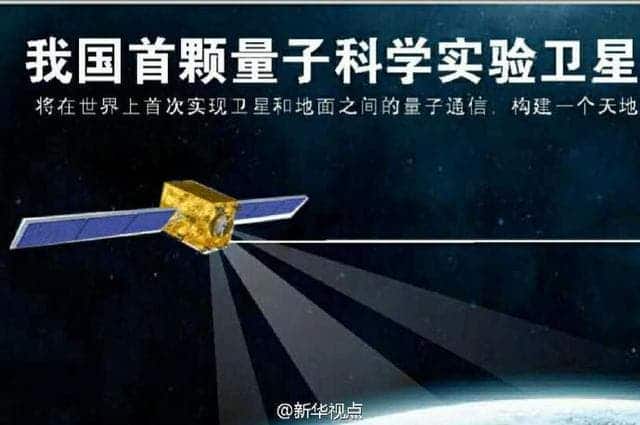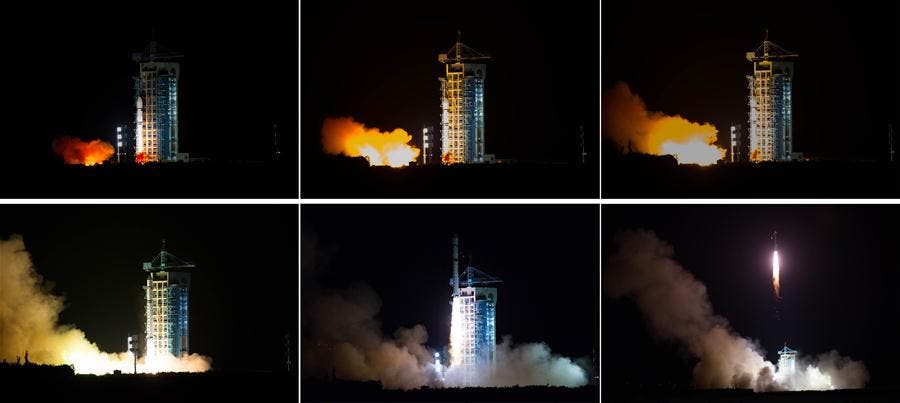
A Long March-2D rocket launched from northwestern China’s Gobi desert dropped the first ever quantum communications satellite into orbit on Tuesday. Once operational, the satellite will transmit and receive quantum encoded information that is virtually unhackable.
“It moves the challenge for an eavesdropper to a different domain,” said Alexander Ling, principal investigator at the Centre for Quantum Technologies in Singapore. “Lots of people around the world think having secure communications at a quantum level is important. The Europeans, the Americans had the lead, but now the Chinese are showing the way forward,” he added.
Named after the Chinese scientist ‘Micius’, the quantum satellite employs a crystal that produces entangled pairs of photons. These entangled photons have properties that are intertwined, so when one photon changes its state, say its spin, the other instantly responds even if they’re worlds apart. And I mean instantly. This sort of quantum madness has been called by Einstein “spooky action at a distance” for very good reason. That was almost a century ago and now we’re finally seeing quantum communications being put to good use.
By exploiting this bizarre quirk of physics, scientists essentially teleported photons over a distance of 143 kilometers across two Canary islands. Once operational, Micius will be the first instrument to use entanglement to communicate from space.

During its two-year experimental mission, Micius will perform a statistical measurement known as Bell’s test to see whether or not it is indeed possible for particles to remain entangled over distances greater than 1,200 km. But first, the craft will align itself with ground stations in Beijing and Vienna and fire entangled particles in pairs to generate a secret key.
Only authorized people back on Earth will be able to read the data. A hacker trying to decode the message will cause the information to be altered or deleted, making communications air-tight.
“If someone tries to intercept [a particle] when it’s being transmitted, by touching it, they make it burst,” Gregoir Ribordy of Geneva-based quantum cryptography firm ID Quantique told the WSJ.
That’s if Micius ever manages to align itself in the right way. For this quantum communication to work, the craft needs to be oriented with pinpoint accuracy to a location on Earth.
“It’s very difficult to point the satellite accurately,” Ling said. “You’re trying to send a beam of light from a satellite that’s 310 miles (500 kilometres) above you.”
Even if Micius fails, other satellites will follow in its footsteps simply because quantum communication is the future.
“The theory is already there, the technology is almost there,’ Hoi Fung Chau, a professor and quantum communications researcher at Hong Kong University, said in a statement. “It’s just a matter of time.”
Besides China, other groups are experimenting with quantum communications. The National University of Singapore (NUS) and the University of Strathclyde, UK launched last year a tiny satellite, called a cubesat, that created and measured pairs of correlated photons. Physicists at the University of Waterloo are planning to generate entangled particles on Earth and beam them to a satellite — the reverse of Micius’ process. There’s a plan to implement quantum communication experiments on the International Space Station (ISS).
Quantum communications might be the most lucrative in military and corporate applications, but ultimately a fleet of such satellites could lead to a quantum internet of sorts. About 20 satellites would be required to enable secure communications throughout the world. Perhaps the most fabulous application would be to combine photons from quantum communication satellites to make a telescope with the apparent aperture the size of planet Earth.
“You could not just see planets,” says Paul Kwiat, a physicist at the University of Illinois at Urbana–Champaign who is working with NASA on the ISS project, “but in principle read licence plates on Jupiter’s moons.”






